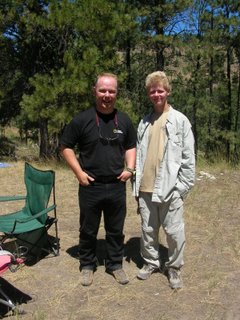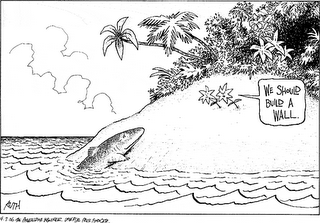Whale fossil sports fierce teeth
Elli Leadbeater
Palaeontologists have discovered a bizarre whale fossil in Australia with a set of fearsome teeth. The specimen has surprised scientists because it belongs to the group known as baleen whales. Modern day baleen whales are all placid, plankton eaters, but the new fossil shows the group were not always the ocean's gentle giants. Details of the 25 million-year-old find appear in the journal Proceedings of the Royal Society B. The small, large-eyed baleen whale used a fully developed set of teeth to hunt its prey. Scientists had thought that two groups of ancient whales evolved drastically different eating habits more than 34 million years ago.
They believed ancient whales that fed by filter feeding evolved to become today's enormous but passive baleen whales, and those that hunted became the ocean's giant predators, the toothed whales. Toothed whales include the killer whale, sperm whale and dolphin, whereas baleen whales are typified by the humpback and blue whale. The new specimen shows that ancient baleen whales probably hunted prey like their toothed relatives.
Modern-day baleen whales are named after their characteristic baleen, a comb-like structure between their jaws which allows them to filter tiny plankton from the sea to eat. Baleen is made of a substance called keratin, just like our fingernails and hair. "Specialised skull features tell us that this fossil is undoubtedly a baleen whale," said lead researcher Erich Fitzgerald of the University of Monash in Victoria, Australia.
"Surprisingly, it appears that the original features of baleen whales did not include the filter-feeding apparatus." Instead, the newly-discovered ancient whale probably used its large, sharp teeth to capture and chew prey, which it located using its large eyes.
"It's always been known that ancient baleen whales had teeth, but this fossil is very important because it looks like the teeth were not used for filter feeding," commented Mark Uhen, head of research at the Cranbrook Institute of Science in Michigan, US. The fossil represents a previously unknown species, named Janjucetus hunderi after its teenage finder Staumn Hunter, who noticed it in an exposed boulder while surfing in 1997.
Janjucetus hunderi lived between 25 and 9 million years ago after the last common ancestor of the toothed and baleen whales. The species also has unusual hearing. Unlike modern baleen whales, this animal's hearing was probably specialised to detect very high-pitched sounds. This is similar to toothed whales, who now "echolocate", producing high-pitched soundwaves and listening to the echos to find prey.
Janjucetus' living descendents, the baleen whales, appear to have lost this ability, possibly because they no longer hunt large prey. Instead, their ears detect the very low-frequency bass sounds which we associate with whalesong. Despite its high-frequency hearing, the unusually large eyes of Janjucetus suggest that it probably used sight to find food items.










